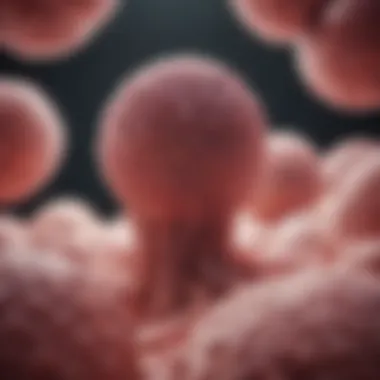Understanding Testicular Cancer: Causes and Risk Factors


Intro
Testicular cancer is a condition that affects a small percentage of men, yet it poses serious health risks, especially for those aged between 15 and 35 years. Understanding this cancer involves an exploration of its causes and the factors that elevate one’s risk of developing it. The interplay of genetics, environment, and lifestyle choices cannot be overstated. Each element helps in shedding light on how this disease manifests and progresses.
Research Highlights
Key Findings
Research shows that testicular cancer primarily affects young men, with a significant number of cases diagnosed in the aforementioned age range. Here are some key findings:
- Genetic predisposition plays a crucial role in testicular cancer development. Men with a family history of the disease are at a higher risk.
- Certain environmental factors, such as exposure to chemicals or radiation, can increase the likelihood of developing testicular cancer.
- Lifestyle choices, particularly smoking and obesity, are associated with a raised risk of the disease.
- Early detection is critical. Men should perform regular self-examinations to identify abnormalities early.
Implications and Applications
Understanding the causes and risk factors can lead to better prevention strategies. Educators and healthcare professionals might develop programs focusing on awareness and education. These programs can encourage early detection and ultimately reduce mortality rates associated with testicular cancer. By sharing this knowledge, we contribute to public health and potentially save lives.
Methodology Overview
Research Design
Studies investigating testicular cancer often employ retrospective or prospective cohort designs. These methods allow researchers to gather data from various groups over time, analyzing different risk factors associated with the disease.
Experimental Procedures
Researchers typically use a combination of surveys, medical examinations, and genetic testing. These approaches help to identify trends and draw connections between risk factors and testicular cancer incidence. For example, data collection tools might include:
- Questionnaires to assess lifestyle and family history.
- Medical imaging to diagnose the disease.
- Biopsy results to study cancer cells and their characteristics.
Understanding these elements contributes not only to knowledge but also to practical applications in healthcare settings, where prevention and early intervention remain paramount. Through continued research, new insights will emerge, fostering a more informed approach to managing testicular cancer.
Prelims to Testicular Cancer
Testicular cancer merits attention due to its increasing incidence among young men, particularly those aged between 15 and 35 years. Understanding the intricate dynamics of this disease is essential for educating those at risk and enhancing preventive strategies. The focus on testicular cancer is more than a statistical analysis; it encompasses the lived experiences of individuals and their families.
This section serves to introduce the key aspects of testicular cancer. It outlines the significance of being aware of this type of cancer, discussing how early detection and awareness can lead to improved outcomes. Providing a clear overview of the disease helps equip readers with critical information, fostering a proactive approach to health.
Overview of Testicular Cancer
Testicular cancer develops in the testicles, which are part of the male reproductive system. The cancerous growth can occur in various forms, often starting from germ cells. There are several types of tumors, but the majority fall into two main categories: seminomas and non-seminomas. Understanding these distinctions is vital for recognizing the different treatment options available.
The causes of testicular cancer remain partially understood. Genetic, hormonal and environmental factors have all been implicated, alongside potential lifestyle influences. The investigation into these causes continues as researchers seek to identify specific mechanisms that can lead to cancer development.
Epidemiology and Prevalence
The epidemiology of testicular cancer reveals important trends. It is one of the most common cancers in young men, with its peak incidence occurring in the late teens to early thirties. According to data from various health organizations, the prevalence is rising in certain regions, specifically in Western countries. This has prompted a closer examination of demographic variables, including ethnicity and family history, which appear to influence disease risk.
The survival rate for testicular cancer is relatively high, with most patients experiencing positive outcomes, especially if detected early. The rise in awareness campaigns and screening programs may contribute to increased diagnoses and better prognosis.
"Awareness and understanding of testicular cancer are crucial in promoting early detection and improving patient outcomes."
Furthermore, supportive resources exist for patients and their families, helping them navigate the complexities of diagnosis and treatment. As education spreads, it becomes essential to dispel myths and foster informed conversations surrounding testicular cancer.
Defining Testicular Cancer
Defining testicular cancer is crucial for understanding the disease and its implications. This section elucidates the types and stages of testicular cancer, enabling a clearer picture of how the disease develops and progresses. Recognizing these elements aids in diagnosis and treatment choices, fostering awareness about this health issue.


Types of Testicular Cancer
The classification of testicular cancer into different types provides valuable insights into treatment and prognosis.
Seminomas
Seminomas represent a specific type of testicular cancer notable for their relatively slow growth. Characteristically, seminomas tend to occur in younger men, primarily between the ages of 25 and 45. One significant aspect of seminomas is their responsiveness to treatment. They are often treated with a combination of surgery and radiation, making them manageable in cases diagnosed early. Their unique feature is the possibility of curative outcomes, as they have a high rate of survival when detected in the initial stages.
Non-Seminomas
Non-seminomas are a broader category that encompasses several subtypes, such as embryonal carcinoma and yolk sac tumor. These tumors generally grow more rapidly than seminomas and often exhibit more aggressive behavior. The presence of non-seminomas can complicate treatment decisions due to their variability and response to therapies. A key characteristic is their occurrence across a wider age range compared to seminomas. Despite their challenges, understanding non-seminomas aids in the identification of treatment strategies tailored to their unique structures and growth patterns.
Stages of Testicular Cancer
The staging of testicular cancer is critical in determining the treatment plan and potential outcomes. Each stage indicates the extent to which cancer has spread.
Stage
In Stage I, cancer is confined to the testicle. This stage is often asymptomatic, making awareness vital. Patients may experience slight swelling or a lump that leads them to seek medical advice. The importance of early detection cannot be understated, as Stage I testicular cancer has a high cure rate when treated properly. Surgical removal of the affected testicle is typically the first line of treatment, followed by surveillance or additional therapies depending on further evaluations.
Stage
Stage II indicates that cancer has spread to nearby lymph nodes. Patients may have more noticeable symptoms compared to Stage I. The diagnostic focus at this stage often includes imaging tests to evaluate lymph node involvement. Treatment usually involves surgically removing the affected testicle and possibly the involved lymph nodes, followed by chemotherapy if necessary. Understanding Stage II is essential for informing treatment strategies that aim for long-term remission.
Stage
In Stage III, the cancer has spread beyond the testicle and lymph nodes, potentially affecting other organs. This stage presents a more complex situation that necessitates a comprehensive treatment approach, often involving chemotherapy and, in some cases, radiation. Patients in Stage III may experience significant symptoms, prompting prompt medical attention. Knowledge of this stage is critical; it emphasizes the need for immediate intervention to mitigate further complications and improve survival rates.
Understanding the types and stages of testicular cancer lays the foundation for effective diagnosis and treatment strategies, essential for improving patient outcomes.
Etiology of Testicular Cancer
Understanding the etiology of testicular cancer is crucial, as it allows us to identify the roots of the disease and its associated risk factors. Through this lens, we can explore genetic components and hormonal influences that play a significant role in developing this cancer. This section provides insight into the underlying mechanisms driving testicular cancer, emphasizing the importance of awareness, early detection, and risk assessment.
Genetic Factors
Hereditary Syndromes
Hereditary syndromes are genetic conditions that can increase the likelihood of developing testicular cancer. One relevant characteristic of these syndromes is their familial connection; they can often be traced through generations. This makes it beneficial in identifying individuals who may be at higher risk. Understanding hereditary syndromes helps in the planning for preventive measures and early screening strategies. The unique aspect of hereditary syndromes is that they highlight the significance of genetics in cancer development, offering families the chance to take precautionary actions. However, relying on genetic predisposition can lead to anxiety about an inherited risk, which should be managed carefully.
Chromosomal Abnormalities
Chromosomal abnormalities refer to changes in the normal structure or number of chromosomes. They have a direct influence on cancer risk, including testicular cancer. These abnormalities may arise from various factors, such as environmental exposure or developmental issues. A key characteristic is their role in disrupting normal cell growth, which may lead to tumor formation. They are a pertinent choice for this article due to their scientific relevance and increasing recognition in cancer research. A unique feature of chromosomal abnormalities is that they can occur sporadically or as a part of a hereditary pattern. Understanding these alterations can help in risk stratification, providing a basis for developing targeted therapies. The challenge lies in the complexity of interpreting these abnormalities, as not all lead to direct cancer development.
Hormonal Influences
Testosterone Levels
Testosterone levels significantly contribute to the development of testicular cancer. Low or abnormal testosterone levels can disrupt normal testicular function, making it a compelling area of study. A distinctive characteristic is the hormone's role in regulating several physiological processes that influence male health. This makes it a valuable focus when discussing risk factors for testicular cancer. The unique aspect of studying testosterone levels is their modifiable nature, as hormone replacement therapies can potentially mitigate risks. However, high testosterone levels are not entirely protective, which complicates the narrative.
Prenatal Hormonal Environment
The prenatal hormonal environment has lasting effects on a male’s reproductive health. It can alter the growth and development of the testes before birth. This area of study holds importance because it emphasizes that factors influencing health begin well before birth. A key characteristic is that variations in hormone exposures during critical developmental windows can lead to long-term consequences. This makes it a relevant choice for our discussion. The unique feature of the prenatal environment is that it opens a dialogue about the impact of maternal health on future generations. However, extracting causal relationships remains challenging, making it a complex field of study.
Lifestyle Risk Factors


Understanding lifestyle risk factors is a critical component of comprehending testicular cancer. These factors can significantly influence an individual’s likelihood of developing the disease. While genetics and environment play pivotal roles, personal choices and medical history often intersect with broader health concerns. Addressing lifestyle factors provides feasible strategies for risk reduction, leading to greater awareness and preventive measures.
Age and Testicular Cancer
Age is a significant risk factor for testicular cancer, especially among younger males. The highest incidence of testicular cancer occurs in men between the ages of 15 and 35. Men in this age group should be particularly vigilant, as early detection is vital for treatment success. Monitoring for any irregularities in the testicles becomes crucial during this life stage. Furthermore, the unique hormonal and physiological changes during adolescence contribute to an increased susceptibility to this cancer.
Cryptorchidism
Cryptorchidism, or undescended testicles, is a well-established risk factor for testicular cancer. Males born with this condition have a higher likelihood of developing the disease later in life. Studies indicate that surgical correction of cryptorchidism may reduce the risk, but individuals still face elevated chances compared to the general population. Parents should be aware of this condition and ensure prompt medical evaluation, as early intervention can lead to better outcomes.
Infertility and Conditions
Infertility has been linked to an increased risk of several health issues, including testicular cancer. Men with fertility problems should discuss their health history with a physician. Conditions such as low sperm production or hormonal imbalances could indicate underlying problems, which in turn might elevate the risk of developing cancer. Regular screenings and open discussions regarding reproductive health can aid in early detection and intervention.
Obesity and Body Mass Index (BMI)
Obesity has emerged as a critical lifestyle factor that may influence the risk of testicular cancer. Research suggests that higher body mass index (BMI) can be associated with various malignancies, including those affecting the testes. Excess weight can affect hormone levels, potentially promoting cancerous changes. Maintaining a healthy weight through proper diet and regular exercise can serve as preventive measures. Aiming for a BMI within the normal range not only supports overall health but may also lower cancer risk.
"Lifestyle modifications can play a role in reducing the risk of developing testicular cancer. Awareness is key to prevention."
Understanding these lifestyle risk factors enables individuals to be proactive about their health. It is essential to consider age, medical history, and bodily changes to maintain awareness. Incorporating healthy habits and seeking regular medical advice will assist in minimizing potential risks associated with testicular cancer.
Environmental Factors
The role of environmental factors in the context of testicular cancer is a critical aspect that warrants thorough examination. Research suggests that exposure to certain chemicals and radiation may elevate the risk of developing this type of cancer. Understanding these influences is vital. Both chemical exposures and radiation can affect cellular processes that might lead to cancer. Thus, examining these environmental risk factors adds depth to our overall comprehension of testicular cancer.
Chemical Exposures
Pesticides
Pesticides are substances used for eliminating pests that can harm crops and livestock. The link between pesticide exposure and testicular cancer has been a subject of investigation. Studies show that individuals working in agriculture may face higher risks due to regular exposure to these chemicals. One key characteristic of pesticides is their potential endocrine-disrupting capabilities. These substances can interfere with hormonal systems in the body, which can be a factor in cancer development.
Pesticides highlight significant concerns in testicular cancer research. Their unique feature is their widespread usage; they are prevalent in many regions and can be found in food products. This exposure can be cumulative, leading to long-term effects that might not be immediately apparent. The advantage of focusing on pesticides in this article is to raise awareness of occupational and residential exposure and to advocate for safer agricultural practices.
Industrial Chemicals
Industrial chemicals include a variety of substances used in manufacturing and production processes. The impact of these chemicals on health, particularly concerning testicular cancer, cannot be overlooked. Many industrial chemicals are classified as carcinogens. One important characteristic of these chemicals is their persistence in the environment and the human body.
These substances are key considerations when discussing risk factors. Their unique feature is their often-invisible nature; many individuals may unknowingly be exposed due to their use in everyday products or the environment. Addressing industrial chemicals adds a layer of complexity to our understanding of environmental factors in testicular cancer. While industrial chemicals offer benefits in manufacturing efficiencies, the disadvantages involve long-term health consequences that require focused regulatory oversight and ongoing research.
Radiation Exposure
Medical Radiation
Medical radiation is a crucial factor when examining testicular cancer risk. Many diagnostic and treatment procedures utilize radiation, raising concerns about exposure levels. The key characteristic of medical radiation is its targeted and often necessary role in healthcare, particularly in imaging procedures like X-rays and CT scans.
However, extensive exposure to medical radiation has been linked to a higher risk of developing various cancers, including testicular cancer. The unique feature of medical radiation is that while it provides diagnostic benefits, it can also pose a risk if used excessively or without proper safeguards. This article's emphasis on medical radiation underscores the need for judicious use and patient awareness of potential risks associated with medical procedures.
Environmental Radiation
Environmental radiation comes from natural and artificial sources. Natural sources include cosmic rays and radon, while artificial sources can involve nuclear plant emissions. The characteristic about environmental radiation is that it is omnipresent; everyone is exposed to some level of it daily.
The connection between environmental radiation and testicular cancer is a growing area of concern. Increased levels of exposure can elevate cancer risk. The unique aspect of environmental radiation is that it is challenging to control or mitigate in certain areas. Thus, it is essential to recognize its presence and investigate its implications thoroughly.
Awareness of environmental radiation contributes significantly to the understanding of testicular cancer risk, highlighting the need for policies aimed at minimizing exposure through effective regulations.


In summary, the exploration of environmental factors—chemical exposures and radiation—is essential for understanding testicular cancer. Identifying these factors helps craft strategies for prevention and awareness, making it a valuable component of health discussions.
Inherited Syndromes and Conditions
Inherited syndromes and conditions play a critical role in understanding the causes of testicular cancer. These genetic predispositions can significantly heighten an individual's risk of developing this type of cancer. By examining inherited conditions, we can identify potential warning signs that may indicate higher susceptibility. This knowledge can lead to earlier detection and possibly more effective intervention strategies. It is essential for those with a family history or known genetic syndromes to be proactive and consult healthcare professionals for guidance and screenings.
Klinefelter Syndrome
Klinefelter syndrome is a chromosomal condition affecting males, characterized by the presence of an extra X chromosome. Typically, males have one X and one Y chromosome. Those with Klinefelter syndrome usually have an XXY pattern. This condition can lead to various physical and developmental challenges, including infertility and reduced testosterone levels.
Importantly, men with Klinefelter syndrome face a significantly higher risk of testicular cancer than those without it. Studies suggest that they may have a lifetime incidence of about 20%. Individuals with the syndrome often exhibit smaller testicles and a higher tendency toward breast tissue development, both of which require careful monitoring by healthcare providers.
Family History
Family history is another crucial consideration when discussing testicular cancer. Men with a close relative who has had testicular cancer are at increased risk themselves. Research indicates that having a father or brother with a history of the disease increases an individual’s risk by about four to ten times compared to those without such a familial link.
This heightened risk emphasizes the importance of genetics in cancer predisposition. Men with a known family history may benefit from regular self-examinations and consultations with healthcare providers about potential screening options. Family history encourages proactive health management, leading to early detection and better outcomes.
Understanding inherited syndromes like Klinefelter syndrome, as well as recognizing family history, is crucial in identifying individuals who may be more susceptible to testicular cancer. This awareness is a fundamental step toward effective prevention and treatment strategies.
Signs and Symptoms
Understanding the signs and symptoms of testicular cancer is vital for early detection and effective treatment. Prompt recognition of these indicators can greatly enhance the chances of successful outcomes. The article delves into common and advanced symptoms, providing essential information that empowers individuals to seek medical advice. By being informed, one can contribute significant knowledge to discussions about men's health and raise awareness among peers.
Common Symptoms
Common symptoms of testicular cancer generally start with subtle changes that one may notice in the body. Some of these symptoms include:
- Lump or swelling in the testicle: Often, this is the first and most noticeable symptom. It may appear as a hard mass. Unlike benign conditions, this lump does not typically cause pain initially.
- Discomfort or pain in the testicle: Some individuals may experience a sensation of heaviness or an ache in the testicle or scrotum. This can also be localized to the lower abdomen.
- Changes in the size or shape of a testicle: Any noticeable change in size, especially if uneven with the other testicle, should raise concern.
- Fluid accumulation: Swelling can occur due to fluid buildup, often around the scrotum. This may lead men to feel discomfort.
- Pain in lower back or groin: Discomfort can radiate to these areas, indicating possible advanced disease.
These symptoms can be easily overlooked or mistaken for less serious health conditions. This makes understanding and monitoring one's body crucial in mitigating risks associated with testicular cancer.
Advanced Symptoms
As testicular cancer progresses without treatment, additional symptoms may arise, signaling the need for immediate medical attention. Advanced symptoms may include:
- Breast development or tenderness: Known as gynecomastia, this can result from hormonal changes in advanced cancer.
- Persistent pain: Unlike the initial discomfort, pain may become more severe and consistent, often linked with cancer spreading.
- Weight loss: Unexplained weight loss can indicate progression of the disease or metabolic changes occurring in the body.
- Shortness of breath: This may happen if cancer spreads to the lungs, causing respiratory issues.
- Neurological symptoms: Headaches or changes in vision can occur if cancer metastasizes to the brain.
It is vital for individuals to recognize these advanced signs as indicators of a serious health issue. Early detection can significantly affect treatment efficacy. Monitoring one's body and being aware of these symptoms not only aids in personal health but contributes to a broader understanding of testicular cancer within the community.
"An informed individual is an empowered individual. Understanding signs and symptoms is key to early diagnosis and better outcomes."
Overall, the significance of being aware of both common and advanced symptoms cannot be underestimated. Those in the target demographic, especially young males, should prioritize regular self-examinations and discussions with healthcare professionals regarding their findings.
The End and Future Perspectives
The discussion surrounding testicular cancer encompasses many layers, from understanding its causes to identifying risk factors. Such exploration not only aids in awareness but also contributes to ongoing research efforts. The conclusions derived from studying this disease can lead to improved preventive strategies and ultimately, better outcomes for those affected.
Current Research Trends
Research on testicular cancer is continuously evolving. Scholars focus on several key areas:
- Genetic Studies: Understanding the genetic mutations that may increase susceptibility to testicular cancer is an active area of inquiry. Advanced genetic testing and analyses enable researchers to identify high-risk populations and tailor surveillance efforts effectively.
- Long-term Survivorship: As survival rates improve, studies increasingly examine long-term effects and the quality of life for survivors. Researchers assess the psychological, physical, and social impacts of surviving this disease over time.
- Targeted Therapies: Developing targeted therapies that can improve treatment outcomes with fewer side effects is crucial. Treatments such as immunotherapy are garnering interest, pushing the envelope on current treatment regimens.
- Screening and Diagnosis: Finding methods for early detection remains pivotal. Research aims to refine current screening techniques and develop potential biomarkers that could signal early-stage testicular cancer.
Preventive Measures and Awareness
Preventive measures play a vital role in combatting testicular cancer. Awareness campaigns can educate individuals on self-examinations. Men should be encouraged to perform monthly self-checks for any abnormal changes in the testicular area. This simple practice can lead to earlier detection of potential issues.
Moreover, outreach programs focusing on at-risk populations are essential. Increasing awareness regarding the links between conditions such as cryptorchidism and testicular cancer can empower individuals to seek medical advice. Other preventive steps include:
- Healthy Lifestyle Choices: Maintaining a healthy body weight and regular exercise may play a role in reducing the risk of various cancers, including testicular cancer.
- Regular Check-ups: Routine medical examinations should be part of a man’s health strategy, as they provide opportunities for professionals to identify any noticeable changes or symptoms early.



